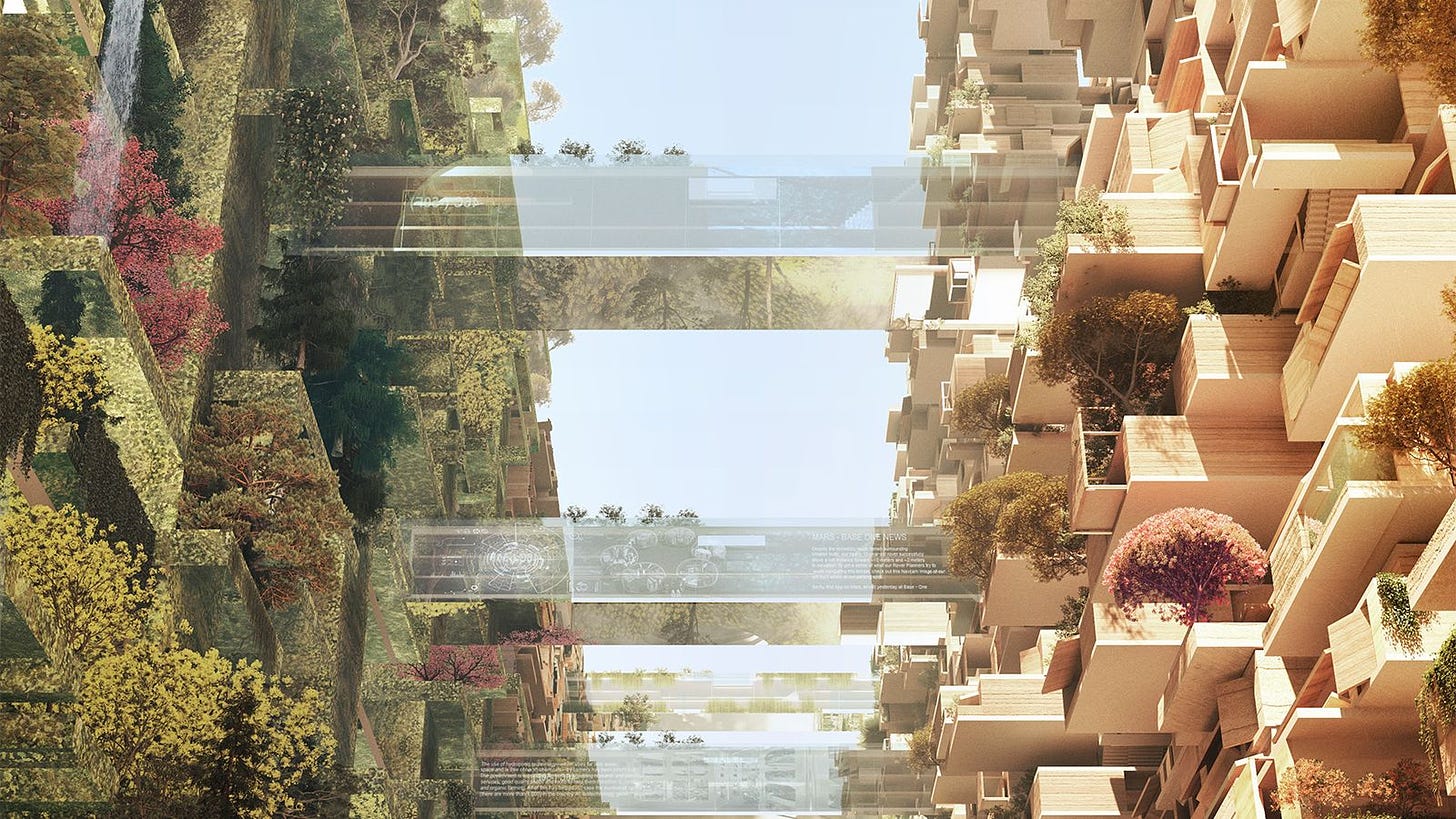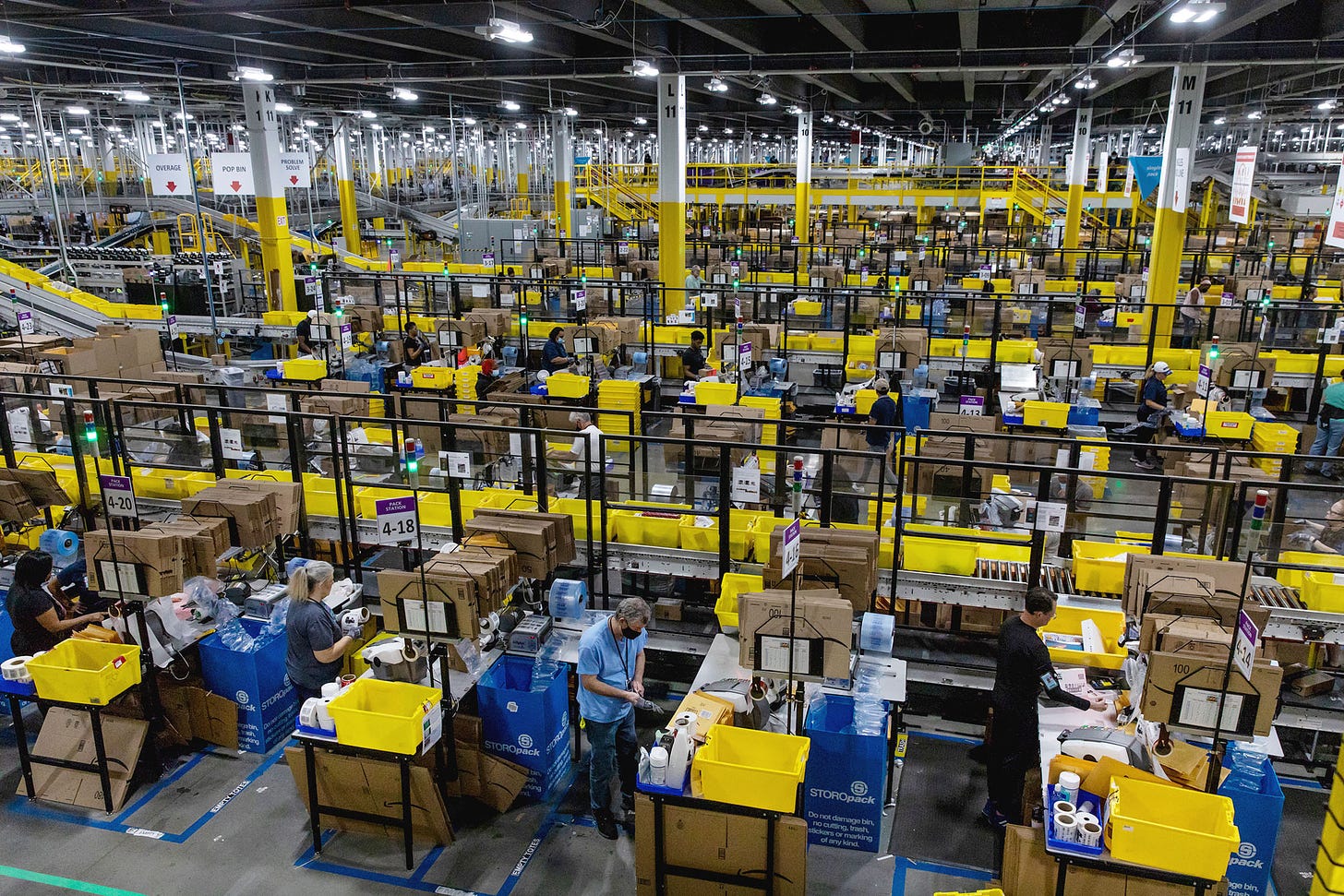This essay was originally published by Engelsberg Ideas in January 2024.
In January, the architecture studio Hassell published designs for a settlement to house 144 people on the moon. Commissioned by the European Space Agency (ESA), this ‘Lunar Habitat Master Plan’ shows a series of inflatable pods in which settlers will live, eat, exercise and cultivate plants. A protective shell of lunar soil, to be 3D-printed on site, will shield the structures from devastating levels of radiation on the moon’s surface. Nor will this life be without leisure and style. Hassell’s renderings include a cocktail bar with elegant coffee tables, atmospheric lighting, and moulded chairs that carefully echo the imagery of science fiction.
This proposal is just the latest in a growing genre of architectural projects for sites beyond Earth. The last decade has seen a flurry of eye-catching designs for both the moon and Mars. Hassell has previously imagined something even more swish than its lunar cocktail bar: a Martian abode with timber-effect flooring, houseplants and minimalist furniture. It is a vision fit for an IKEA advert, down to the young couple whose relaxing evening we can glimpse through the generous picture window. Meanwhile, NASA has enlisted architects from two studios, Bjarke Ingels Group and SEArch +, to work on lunar structures. Both firms have already been involved in space-related projects, with the latter proposing a Martian community living in igloos of sculpted ice.
Another idea for Mars comes from the high-profile Foster + Partners: mound-like dwellings of fused rubble, assembled by teams of robots arriving via parachute. Perhaps the most ambitious concept, courtesy of the architects at Abiboo, imagines a vast rabbit warren of tunnels embedded in a Martian cliff-face, containing a metropolis of 250,000 people.
I could go on, but it should already be apparent that this burgeoning field of space architecture involves considerably more fantasy than concrete planning. The problem is not necessarily a lack of detail: many projects indulge in technical discussion of materials, construction methods and service systems. But given that the longest habitation of the moon to date was the three days the Apollo 17 crew spent camping in their rover in 1972, while no person has ever set foot on Mars, it is clear these futuristic structures and fashionable interiors really belong to the realm of science fiction. We shouldn’t be surprised that the winners of one NASA competition for a Mars base also want to‘harness the power of comets for interplanetary transportation’, or that Abiboo’s Martian city proposal requires steel-making technology ‘that will need to be developed’.
So what exactly is the point of these designs, and why are agencies such as NASA and the ESA bothering to commission them? Ultimately, speculative space projects tell us more about architecture as a practice and an industry here on Earth than they do about future settlements on distant celestial bodies. This is not to say that such schemes will never bear fruit, but such fruits are likely to emerge much closer to home, as part of architecture’s ongoing fascination with the idea of space.
The notion of lunar or Martian architecture is not necessarily absurd. We are on the cusp of a new Space Age, and this time the aim is not just to visit other parts of the solar system, but to establish a lasting presence there. The first destination is the south pole of the moon, where there are craters containing frozen water. Last August, India’s Chandrayaan-3 mission landed an unmanned spacecraft tere for the first time. The main players, however, are the United States and China, who have both assembled international coalitions for space exploration. NASA’s Artemis program, in cooperation with more than 30 nations, hopes to have astronauts at the lunar pole by the end of the decade, and built structures in place by 2040. Unlike the earlier Apollo missions, Artemis can draw on a buoyant private-sector space industry, including rockets and spacecraft designed by Elon Musk’s SpaceX. Musk has claimed that he is amassing his vast personal wealth in order to make humanity a ‘multi-planetary species’.
Meanwhile, on a similar timetable, China’s Chang’e program is hoping to establish its own International Lunar Research Station, with partners including Russia, Egypt and Pakistan. Both the American- and Chinese-led efforts have ostensibly scientific aims. The moon promises a wealth of information about the distant past of the solar system, including the formation of Earth itself, but it would be naïve to imagine this new space race is about a disinterested search for knowledge. The moon is expected to furnish valuable supplies of Helium-3, potentially useful for nuclear fusion, as well as rare earth metals. More importantly, the hydrogen and oxygen at the moon’s south pole can be used for rocket propellant, allowing space travellers to continue on to further destinations. This is no longer just idle speculation: all parties now see the moon as a stepping-stone towards the future colonisation of Mars.
The problem is that building anything in these distant places, let alone living there, involves enormous challenges of engineering and logistics. Lunar pioneers will need to endure temperature swings of hundreds of degrees Celsius between day and night, along with constant bombardment by micrometeorites. On Mars, they can look forward to average temperatures of -60C and frequent deadly sandstorms. Both places are subject to intense cancer-causing radiation, and a total absence of soil suitable for growing food. Even breathable air needs to be manufactured.
Space agencies are investigating potential infrastructure for a moon base, including water extraction, satellites for communication, and electricity from solar and nuclear plants. The difficulty of transporting heavy materials such a long way, however, means that any construction will have to make use of the sparse elements already in situ, especially ice, water, and the rubble known as regolith. There will be no workforce, so structures will need to be built robotically or by the astronauts themselves. Before we worry about the aesthetics of the lunar hospitality industry, engineers face a more basic question: can we even make bricks in these conditions? The firm that NASA is hoping will develop its construction technology, the 3D-printing specialists ICON, has only been receiving funding since 2020.
Thinking ahead can be valuable. There is little use developing construction techniques if we don’t have some sense of how we want to employ them. By visualising the endpoint, architecture can help to specify the problems that the engineers need to solve. Besides, living on the moon for an extended period will require much more than engineering. According to architect Hugh Broughton, whose work on polar research bases is providing inspiration for NASA, the deeper problem is ‘how architecture can respond to the human condition’. When designing for extreme conditions, the architect has to consider ‘how you deal with isolation, how you create a sense of community… how you support people in the darkness’. This is worth bearing in mind when we see lunar proposals that resemble a leisure centre or cruise ship. Research bases in the Antarctic include amenities such as cinemas and themed bars. Their purpose is, above all, to provide a sense of familiarity. The German firm Duravit has even considered this psychological need in its design for a Martian toilet, which resembles an earthbound one despite working in a different way.
Nonetheless, there remains an indulgent quality to recent space designs. The Ukrainian studio Makhno has envisaged a Martian settlement along the lines of a luxury spa, complete with swimming pools and bucolic rock gardens. It even has a meditation capsule for ‘recovery, restart of consciousness, and immersion into the inner’. No doubt there is publicity value for architects in these imaginative projects – like the concept cars that automakers show at fairs – but this then raises the question of what virtues architects are trying to showcase, and why space is the appropriate medium.
Decades ago, the architect and critic Kenneth Frampton noted a tendency in the avant-garde to imagine impossible projects, which he diagnosed ‘as the return of a repressed creativity, as the implosion of utopia upon itself’. Frampton was pointing to the tension between the ideals and criteria of excellence that animate modern architecture and the highly constrained reality in which architects actually operate. Architecture aspires to engage with deep problems of social life, and also to achieve aesthetic or technical brilliance. Yet, across much of the developed world, innovative approaches to the built environment are stifled by all manner of restraints, from restrictive planning codes to the profit margins of property developers. There may be more scope for originality when it comes to designing fancy hotels, art museums and corporate office buildings, but such displays tend to make architecture the handmaiden of business or entertainment.
Following Frampton’s critique, we could see space architecture as a means to demonstrate, in the realm of imagery, the ambition and purpose that are so rarely possible in real buildings. Designing for the moon or Mars offers not just the grandeur of a new frontier in human history, but the creative freedom of a genre whose boundaries are yet to be established, and which is in any case largely speculative.
More particularly, these projects allow a kind of imaginative return to the heroic age of modern architecture, the 1920s and 30s. In the turmoil of Europe following the First World War, for a short while it appeared that the designers of buildings and cities could shape the future of humanity. They felt emboldened to break with the past and develop rational, efficient and functional answers to the problems of modern society. The results ranged from the visionary doctrines of Le Corbusier to the granular ingenuity of a figure such as Grete Schütte-Lihotzky, designer of the galley kitchen, whose basic template we still use today. Space architecture provides a similar opportunity to address fundamental questions of design, from materials and form to the arrangement of functions in the overall plan, without the weight of convention obstructing the most elegant solution.
If architects can use space projects as an outlet for repressed creativity, their work serves a rather different purpose for the organisations that commission them. In an era when imagery carries immense power, digital renderings have become a political medium, called on to visualise the imagined marvels of the future. And space exploration is deeply political. It embroils the relevant agencies in a constant struggle for government funds, forcing them to confront public misgivings about the necessity and cost of their activities. Since the Soviet Union launched Sputnik, the first satellite, in 1957, such doubts have been countered in part through the imaginative appeal of the final frontier; an appeal that has only grown with the rise of visual media. In 2020, when NASA’s Perseverance rover explored the surface of Mars, social media users were thrilled to hear audio of Martian winds, and to see a horizon with Earth sparkling in the distance; that this particular photograph turned out to be fake only underscored the role of fantasy in these matters. Architectural imagery gives form to dreams of colonising the solar system. It thereby helps to justify space exploration not just to politicians, but to a wider audience of media consumers.
Space design reveals a peculiar alignment of interests between architects and their clients. The former can apply themselves to a heroic paper architecture – or rather, digital architecture – for which there is little scope on Earth; the latter, meanwhile, can justify their budgets with images that invoke an exciting horizon of possibility. It would be short sighted, however, to consider such projects only in terms of their immediate motives and plausibility.
The consequences of human engagement with space have always been dynamic and unpredictable. Technology provides the clearest examples: NASA laboratories have inadvertently contributed to all kinds of everyday products, from camera phones and baby formula to running shoes and wireless headsets. We can already see the potential for such transfers in the drive to build in other parts of the solar system. At the University of Nebraska, a team led by the engineer Congui Jin has been developing organic construction materials for Mars. Jin thinks that certain kinds of fungi can assemble minerals from Martian sand and grow them into bricks. If successful, such techniques could find numerous applications on Earth, starting with the repair of damaged concrete and provision of refugee housing in remote areas.
Architecture has its own story to tell about the role of space exploration in the modern world. When Kenneth Frampton made his comments about the frivolity of avant-garde ideas, he had in mind a group of students and municipal architects that appeared in Britain during the 1960s, known as Archigram. In their magazine of the same title, the group explored fantastical and futuristic schemes like the ‘Walking City’ (that is, a city with legs) and the ‘Underwater City,’ while devising all manner of pods, capsules and bubbles in which people might one day dwell. These fantasies were informed by the technology and aesthetics of the Space Age. As Archigram 3 put it, architecture needed something ‘to stand alongside the space capsules, computers and throw-away packages of an atomic/electronic age.’ The first issue had invoked ‘the poetry of countdown… [and] orbital helmets,’ while the second took inspiration from ‘Lunar architecture and shredded wheat… the radiator grille and the launching pad.’
Archigram’s provocations were often more outlandish than the space habitats of recent years. And yet, the group’s influence has been profound. Their disciples include leading practitioners of high-tech architecture, such as Norman Foster, Renzo Piano and the now-deceased Richard Rogers, who have designed many of the world’s most notable buildings over the past half-century. While Archigram dreamed of structures that would capture the ethos of the space age, these architects have designed and built them, often using materials and methods borrowed from the aerospace industry. We can even detect Archigram’s spirit in the inflatable pods that feature in many recent proposals for the moon and Mars.
Strangely then, space architecture is not really the fresh departure it appears to be. When we look at new schemes for settlements beyond Earth, we are seeing a long-extant futuristic sensibility that is now straining closer towards material reality. By the same token, even if we don’t see cocktail bars on the moon anytime soon, the ideas stimulated by such projects may still prove influential for the future of design.





